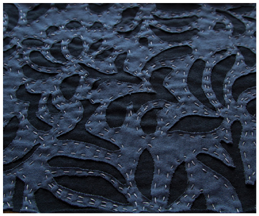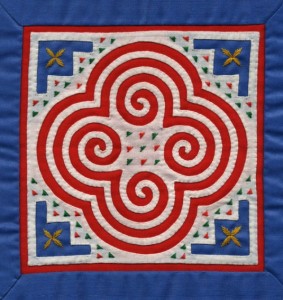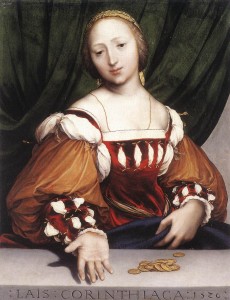What's Out There: Appliqué Goes Beyond Quilting
Back in March I ran across the reverse appliqué techniques of the Alabama Chanin company and was entranced. If you haven’t seen their garments, take a peek at their collection. They have a bit of a boho style, use a lot of cotton jersey fabrics and the designs are worked with regular and reverse applique and beading. The textures are fabulous. While some of it was a bit too shabby chic for me, there’s a LOT to like about the designs. Also, for those of us not often spending upwards of $400 for a skirt, they have produced about four books that have patterns and instructions to create your own Alabama Chanin-inspired looks. I got three from the library, eventually had to order one of them, and there it sat.
 To my delight, I went to the June Quilting group meeting and Teresa was working on the same thing! Great minds think alike for sure—except she managed to actually do hers, as well as design kits for all the rest of us. Fabulous! So I got one of her kits.
To my delight, I went to the June Quilting group meeting and Teresa was working on the same thing! Great minds think alike for sure—except she managed to actually do hers, as well as design kits for all the rest of us. Fabulous! So I got one of her kits.
Alabama Chanin’s designs are a new adaptation of old techniques to add interest and texture to garments. There are two layers of cotton jersey, with the top one being cut away to expose the different color underneath. The stitches add texture, and the fabric does not have to be turned under as the jersey doesn’t ravel.
Other examples of similar reverse applique techniques include the Kuna women of Panama and Columbia.  Their very complex designs were used for the front and back panels of a blouse. Between two and seven layers of woven cotton cloth are used. Each layer is cut away and the edges carefully turned and stitched so no raw edges show. Sometimes the designs are drawn onto the fabric, but often the design will be made up as it is sewn. Additional elements can be added to enhance the design. Decorative embroidery, positive applique, or small slits that show a different color of cloth can all be used to enhance the design. As opposed to the Alabama Chanin large running stitches, molas have nearly invisible stitches. Kuna women are proud of the fineness of their stitches, the exact color match of their thread, and the complexity of their design. A woman will spend several hours each day sewing and young girls begin creating “molitas,” little molas, by the time they are six or seven. Designs can take a couple of weeks to six months to complete. The oldest molas are about 150 years old.
Their very complex designs were used for the front and back panels of a blouse. Between two and seven layers of woven cotton cloth are used. Each layer is cut away and the edges carefully turned and stitched so no raw edges show. Sometimes the designs are drawn onto the fabric, but often the design will be made up as it is sewn. Additional elements can be added to enhance the design. Decorative embroidery, positive applique, or small slits that show a different color of cloth can all be used to enhance the design. As opposed to the Alabama Chanin large running stitches, molas have nearly invisible stitches. Kuna women are proud of the fineness of their stitches, the exact color match of their thread, and the complexity of their design. A woman will spend several hours each day sewing and young girls begin creating “molitas,” little molas, by the time they are six or seven. Designs can take a couple of weeks to six months to complete. The oldest molas are about 150 years old.
 On the other side of the world, the Hmong (pronounced Mung) people in Laos and Vietnam were also making beautiful reverse applique textiles called “Pa nDau” meaning flower cloth. Making one of these lovely appliquéd pieces is painstaking. It takes years of practice to develop the skills needed to do this intricate reverse appliqué. Often these pieces include other embroidery embellishment in addition to the appliqué. They have a rich history of embroidery. There is a beautiful gallery of work here: www.hmongembroidery.org.
On the other side of the world, the Hmong (pronounced Mung) people in Laos and Vietnam were also making beautiful reverse applique textiles called “Pa nDau” meaning flower cloth. Making one of these lovely appliquéd pieces is painstaking. It takes years of practice to develop the skills needed to do this intricate reverse appliqué. Often these pieces include other embroidery embellishment in addition to the appliqué. They have a rich history of embroidery. There is a beautiful gallery of work here: www.hmongembroidery.org.
A bit farther back in time during the Renaissance (1600s), European nobility enjoyed an em bellishment technique called slashing.
bellishment technique called slashing. It was similar to reverse applique in that there were two layers of fabric, and it involved making small cuts in the outer fabric of a garment so as to reveal the inner lining. Slashing was performed on all variety of garments, from men’s doublets, a padded overshirt, and breeches to women’s gowns and even to shoes. The top layer was not necessarily stitched down to the bottom layer, however.
It was similar to reverse applique in that there were two layers of fabric, and it involved making small cuts in the outer fabric of a garment so as to reveal the inner lining. Slashing was performed on all variety of garments, from men’s doublets, a padded overshirt, and breeches to women’s gowns and even to shoes. The top layer was not necessarily stitched down to the bottom layer, however.
It’s fascinating to see how different cultures in different parts of the world interpret a similar technique to adorn their garments. Each are beautiful in their own way.
If you’d like to see some additional examples of the Alabama Chanin process check out Grace Jones blog. Gertie’s blog has a discussion on it on this post. Julie Bowersett has some interesting ideas beyond regular clothing here.
I hope you’re as inspired as I am for some handwork and texture. I’m definitely going with the cotton jersey as there is hope to finish something that does not require perfectly turned under edges or invisible stitching.
Happy Sewing!
Leigh Wheeler
President

